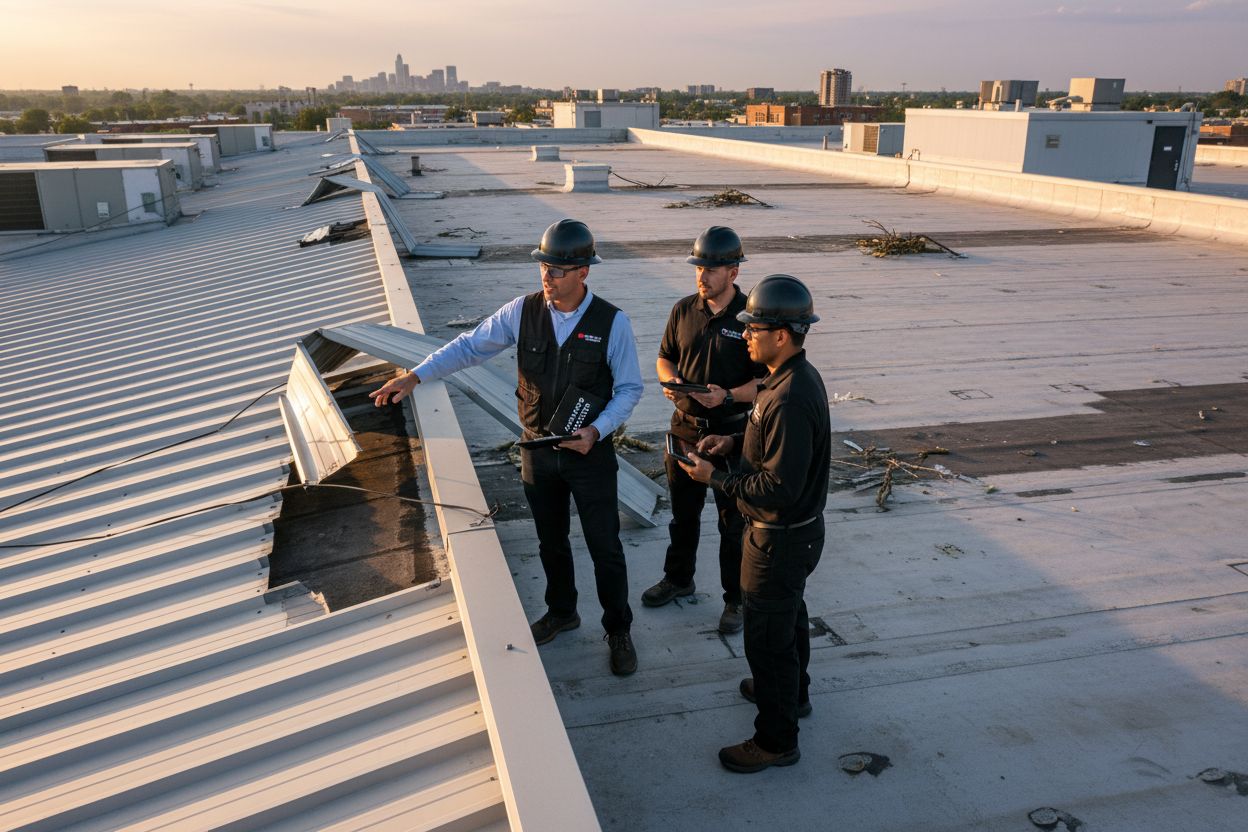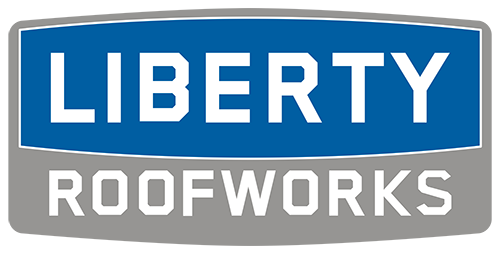Commercial roof wind damage does not wait for a second invitation. Across the United States, wind speeds topping 50 miles per hour can tear, lift, or even rip apart entire roofing systems. Most people picture a few loose shingles, but the real danger is hidden. Because with every gust, small unseen weaknesses start multiplying and can quietly threaten the whole building long before you spot a leak.
Table of Contents
- What Is Wind Damage On Commercial Roofs?
- Why Understanding Wind Damage Matters For Your Business
- How Wind Affects Different Types Of Roofs
- Key Concepts In Assessing Wind Damage Severity
- Real-World Implications Of Wind Damage On Commercial Spaces
Quick Summary
| Takeaway | Explanation |
|---|---|
| Wind damage compromises building safety. | Powerful winds create pressure zones that can lift roofing membranes and weaken structures. |
| Regular inspections are essential. | Proactive assessments help identify vulnerabilities before they lead to significant repair costs and operational disruptions. |
| Financial consequences can be severe. | Unaddressed wind damage can lead to high repair bills, increased insurance costs, and potential business interruptions. |
| Different roofs react uniquely to wind. | Various roofing materials, like membrane and metal systems, have distinct vulnerabilities requiring tailored maintenance strategies. |
| Timely repairs preserve operational continuity. | Addressing wind damage quickly prevents cascading issues that can disrupt business and damage property. |
What Is Wind Damage on Commercial Roofs?
Wind damage on commercial roofs represents a significant and often underestimated threat to building infrastructure. When powerful wind forces interact with commercial roofing systems, they can create substantial structural vulnerabilities that compromise the entire building’s protective envelope. Understanding these dynamics is crucial for property owners and facility managers seeking to maintain robust building integrity.
The Mechanics of Wind Damage
Wind damage occurs through complex aerodynamic interactions between wind velocity, building geometry, and roofing material properties. As wind moves across a commercial roof surface, it creates differential air pressure zones that can systematically weaken roofing components. These pressure variations can cause membrane lifting, edge deterioration, and potential complete roof system failure.
Key mechanisms of wind damage include:
- Negative pressure zones that create upward suction forces
- Localized wind stress concentrations around roof perimeters and corners
- Progressive material fatigue from repeated wind stress cycles
Impact Zones and Vulnerability Assessment
Not all roof areas experience wind damage uniformly. Our guide on understanding common commercial roof problems highlights that specific roof regions are more susceptible to wind-related deterioration. Roof edges, corners, and seam interfaces typically represent the most vulnerable zones where wind can initiate structural compromises.
According to NOAA Wind Hazard Research, wind speeds exceeding 50 miles per hour can create substantial mechanical stress on commercial roofing systems. These high-velocity wind events can progressively weaken roofing materials, creating microscopic tears and separations that eventually lead to more significant structural failures if left unaddressed.
Commercial roofs are engineered with multiple layers and complex material interactions, which means wind damage is rarely a simple, isolated problem. The cumulative effect of wind stress can compromise roof membrane integrity, insulation performance, and overall building envelope protection. Business owners must recognize that wind damage represents a progressive and potentially expensive maintenance challenge requiring proactive assessment and strategic intervention.
Why Understanding Wind Damage Matters for Your Business
Wind damage is not merely a technical roofing concern but a critical business risk management strategy. For commercial property owners, comprehensive understanding of wind damage potential represents a proactive approach to protecting significant financial investments and maintaining operational continuity.
Financial Implications of Roof Wind Damage
The economic consequences of unaddressed wind damage can be substantial. According to Insurance Institute for Business & Home Safety, commercial roof damage can lead to exponential repair costs when left unchecked. Early detection and intervention can potentially save businesses thousands of dollars in comprehensive roof replacement expenses.
Key financial risks include:
- Direct repair and replacement costs
- Potential business interruption and productivity losses
- Increased insurance premiums
- Structural integrity degradation
Operational Disruption and Risk Management
Learn more about storm damage repair strategies that can help mitigate business risks. Wind damage extends beyond physical roof deterioration and can create significant operational challenges. Compromised roofing systems can lead to water intrusion, interior property damage, and potential temporary business closures.
Commercial roof wind damage represents a multifaceted risk that demands strategic attention. By understanding potential vulnerabilities, businesses can develop robust maintenance protocols that minimize unexpected disruptions. Proactive roof assessments, regular professional inspections, and timely repairs are essential components of comprehensive risk management strategies that protect both physical infrastructure and ongoing business operations.
How Wind Affects Different Types of Roofs
Commercial roofing systems are not uniform in their wind resistance capabilities. Different roof types exhibit unique responses to wind forces, making it crucial for property owners to understand how specific roofing materials and designs interact with wind dynamics.
![]()
Membrane Roofing Systems
Explore our comprehensive guide to commercial roof types to better understand wind vulnerability. Membrane roofing systems like TPO (Thermoplastic Polyolefin) and EPDM (Ethylene Propylene Diene Monomer) have distinct wind damage characteristics. These flexible roofing materials can experience significant stress during high wind events, with potential for:
- Edge lifting and membrane separation
- Seam weakening and progressive material fatigue
- Puncture risks from wind-driven debris
Metal Roofing Wind Interactions
Metal roofing presents a more complex wind damage scenario. According to National Roofing Contractors Association, metal roofs can demonstrate remarkable wind resistance when properly installed, but they remain vulnerable at critical connection points. Wind forces can create:
- Panel uplift at roof edges
- Fastener stress and potential system failure
- Potential for systemic material deformation
The engineering of metal roof systems requires precise attachment methods and strategic design considerations to mitigate potential wind damage.
The table below compares the wind damage vulnerabilities and typical effects on two major commercial roofing systems discussed in the article.
| Roof Type | Typical Wind Damage Effects | Key Vulnerabilities |
|---|---|---|
| Membrane (TPO, EPDM) | Edge lifting, membrane separation, seam weakening | Edge zones, seams, puncture from debris |
| Metal | Panel uplift, fastener stress, material deformation | Connection points, edges, improper fastening |
 Proper installation becomes a critical factor in maintaining structural integrity during high wind events.
Proper installation becomes a critical factor in maintaining structural integrity during high wind events.
Key Concepts in Assessing Wind Damage Severity
Effective wind damage assessment requires a systematic and comprehensive approach that goes beyond surface-level visual inspection. Professional roof evaluations demand nuanced understanding of structural integrity, material performance, and potential long-term implications.
Visual Damage Assessment Criteria
Learn more about storm damage evaluation techniques to enhance your diagnostic capabilities. Wind damage severity is determined through multiple diagnostic indicators, which encompass more than just visible exterior deterioration. Professionals analyze critical elements such as:
- Membrane displacement and edge lifting
- Seam separation and material stress points
- Microscopic material degradation
- Underlying structural compromise
Quantitative Damage Measurement
According to ASTM International Standard Guidelines, comprehensive wind damage assessment involves precise measurement techniques that quantify structural vulnerabilities. Sophisticated evaluation methods include:
- Infrared thermal imaging
- Electronic moisture detection
- Pressure testing for systemic integrity
- Precise dimensional measurements of material deformation
Professional roof inspectors utilize advanced diagnostic tools to transform subjective observations into objective, measurable assessments.
These methodical approaches enable accurate determination of wind damage extent, supporting informed decision-making regarding repair or replacement strategies.
Real-World Implications of Wind Damage on Commercial Spaces
Wind damage extends far beyond immediate structural concerns, representing a complex risk landscape that can significantly impact business operations, financial stability, and long-term organizational resilience. Understanding these multifaceted implications is crucial for proactive risk management and strategic decision-making.
Business Continuity and Operational Disruption
Explore our comprehensive storm damage repair strategies to understand potential business interruptions. Wind-induced roof damage can create cascading operational challenges that extend well beyond initial repair considerations. Potential disruptions include:
- Temporary business closure requirements
- Critical equipment and inventory exposure
- Reduced workplace safety conditions
- Potential revenue loss during repair periods
Financial and Insurance Consequences
According to Federal Emergency Management Agency (FEMA) research, wind damage represents a substantial financial risk for commercial enterprises. The economic impact encompasses multiple dimensions, including:
- Direct repair and restoration expenses
- Potential increases in insurance premiums
- Potential legal liability from compromised workplace safety
- Reduced property valuation
Commercial property owners must recognize that wind damage is not merely a maintenance issue but a comprehensive risk management challenge.
This table summarizes the main operational and financial consequences of commercial roof wind damage highlighted in the article for business owners.
| Consequence Category | Examples Provided |
|---|---|
| Operational Disruption | Temporary closure, equipment exposure, safety concerns |
| Financial Impact | Repair costs, insurance premium increases, liability risk |
| Business Continuity Threats | Revenue loss, reduced property value, business interruption |
| Proactive assessment, strategic planning, and timely intervention can mitigate potential long-term financial and operational consequences, transforming potential vulnerabilities into opportunities for enhanced organizational resilience. |
Protect Your Business From the True Cost of Wind Damage
If reading about wind damage on commercial roofs has you worried about hidden risks or expensive business interruptions, you are not alone. Many business owners do not realize how quickly minor roof vulnerabilities can turn into major operational headaches. Wind pressure, membrane lifting, and edge deterioration are real threats that only get worse when ignored. The longer you wait, the higher the chance of costlier repairs and business disruption. Now is the time to address these concerns before the next storm hits.
Do not let wind damage impact your building’s safety or your bottom line. The experienced team at Liberty Roofworks can help you identify weak spots and make repairs with trusted, proven solutions. Explore how our storm damage repair services and commercial roof repair options can give you peace of mind and long-term protection. Connect with us today to schedule your professional assessment and take control of your building’s future.
Frequently Asked Questions
What causes wind damage on commercial roofs?
Wind damage on commercial roofs is primarily caused by powerful wind forces that create differential air pressure zones on the roof surface. These pressures can lead to membrane lifting, edge deterioration, and other structural failures.
How can I assess the vulnerability of my commercial roof to wind damage?
To assess your roof’s vulnerability, focus on areas that typically experience greater stress, such as roof edges, corners, and seams. Conduct regular professional inspections and engage in proactive roof maintenance to identify potential weaknesses before they lead to damage.
What are the financial implications of neglecting wind damage on commercial roofs?
Neglecting wind damage can lead to significant financial consequences, including high repair costs, business interruptions, increased insurance premiums, and deterioration of the structural integrity of the building.
How do different roofing materials react to wind damage?
Different roofing materials respond uniquely to wind forces. For example, membrane roofing systems like TPO and EPDM are susceptible to edge lifting and seam weakening, while metal roofs can experience uplift at edges and fastener stress, highlighting the importance of proper installation and maintenance.
Recommended
- What Is Storm Damage? Understanding Its Impact on Homes – Liberty Roofworks
- Understanding Why Storm Damage Repairs Are Essential – Liberty Roofworks
- Understanding Common Commercial Roof Problems Explained – Liberty Roofworks
- 7 Common Causes of Roof Damage Every Homeowner Should Know – Liberty Roofworks
- Understanding Building Windbreaks for Agriculture – FenceFast Ltd.
